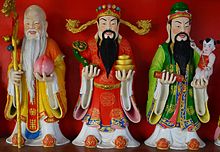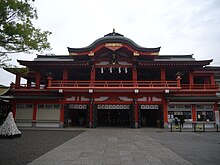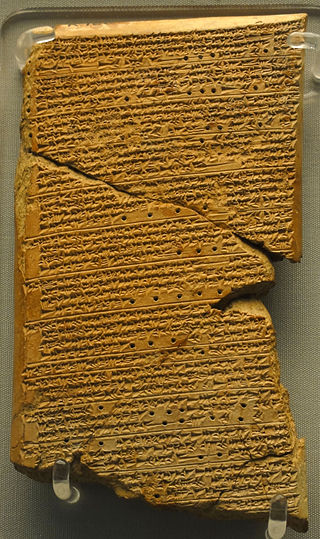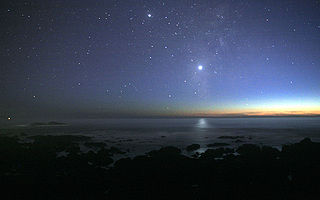Ancient and medieval Near East
Mesopotamia
Babylonian astronomy from early times associates stars with deities, but the identification of the heavens as the residence of an anthropomorphic pantheon, and later of monotheistic God and his retinue of angels, is a later development, gradually replacing the notion of the pantheon residing or convening on the summit of high mountains. Archibald Sayce (1913) argues for a parallelism of the "stellar theology" of Babylon and Egypt, both countries absorbing popular star-worship into the official pantheon of their respective state religions by identification of gods with stars or planets. [1]
The Chaldeans, who came to be seen as the prototypical astrologers and star-worshippers by the Greeks, migrated into Mesopotamia c. 940–860 BCE. [2] Astral religion does not appear to have been common in the Levant prior to the Iron Age, but becomes popular under Assyrian influence around the 7th-century BCE. [3] The Chaldeans gained ascendancy, ruling Babylonia from 608 to 557 BCE. [4] The Hebrew Bible was substantially composed during this period (roughly corresponding to the period of the Babylonian captivity).
Egypt
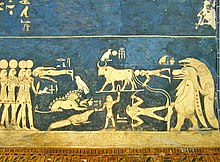
Astral cults were probably an early feature of religion in ancient Egypt. [5] Direct evidence for astral cults, seen alongside the dominant solar theology which arose before the Fifth Dynasty, is found in the Pyramid Texts. [6] The growth of Osiris devotion led to stars being called "followers" of Osiris. [7] They recognized five planets as "stars that know no rest", interpreted as gods who sailed across the sky in barques: Sebegu (perhaps a form of Set), Venus ("the one who crosses"), Mars ("Horus of the horizon"), Jupiter ("Horus who limits the two lands"), and Saturn ("Horus bull of the heavens.") [7]
One of the most notable examples of astral worship in ancient Egypt is the goddess Sopdet, identified with the star Sirius. [8] Sopdet's rising coincided with the annual flooding of the Nile, a crucial event that sustained Egyptian agriculture. The goddess was venerated as a harbinger of the inundation, marking the beginning of a new agricultural cycle and symbolizing fertility and renewal. This connection between Sopdet and the Nile flood underscores the profound link between celestial phenomena and earthly prosperity in ancient Egyptian culture. She was known to the Greeks as Sothis.
Sopdet is the consort of Sah, the personified constellation of Orion near Sirius. Their child Venus [9] was the hawk god Sopdu, [10] "Lord of the East". [11] As the bringer of the New Year and the Nile flood, she was associated with Osiris from an early date [10] and by the Ptolemaic period Sah and Sopdet almost solely appeared in forms conflated with Osiris [12] and Isis. [13] Additionally, the alignment of architectural structures, such as pyramids and temples, with astronomical events reveals the deliberate integration of cosmological concepts into Egypt's built environment. [14]
Sabians
Among the various religious groups which in the 9th and 10th centuries CE came to be identified with the mysterious Sabians mentioned in the Quran (sometimes also spelled 'Sabaeans' or 'Sabeans', but not to be confused with the Sabaeans of South Arabia), [15] at least two groups appear to have engaged in some kind of star worship.
By far the most famous of these two are the Sabians of Harran, adherents of a Hellenized Semitic pagan religion that had managed to survive during the early Islamic period in the Upper Mesopotamian city of Harran. [16] They were described by Syriac Christian heresiographers as star worshippers. [17] Most of the scholars and courtiers working for the Abbasid and Buyid dynasties in Baghdad during the ninth–eleventh centuries who were known as 'Sabians' were either members of this Harranian religion or descendants of such members, most notably the Harranian astronomers and mathematicians Thabit ibn Qurra (died 901) and al-Battani (died 929). [18] There has been some speculation on whether these Sabian families in Baghdad, on whom most of our information about the Harranian Sabians indirectly depends, may have practiced a different, more philosophically inspired variant of the original Harranian religion. [19] However, apart from the fact that it contains traces of Babylonian and Hellenistic religion, and that an important place was taken by planets (to whom ritual sacrifices were made), little is known about Harranian Sabianism. [20] They have been variously described by scholars as (neo)-Platonists, Hermeticists, or Gnostics, but there is no firm evidence for any of these identifications. [21] [lower-alpha 1]
Apart from the Sabians of Harran, there were also various religious groups living in the Mesopotamian Marshes who were called the 'Sabians of the Marshes' (Arabic: Ṣābiʾat al-baṭāʾiḥ). [22] Though this name has often been understood as a reference to the Mandaeans, there was in fact at least one other religious group living in the marshlands of Southern Iraq. [23] This group still held on to a pagan belief related to Babylonian religion, in which Mesopotamian gods had already been venerated in the form of planets and stars since antiquity. [24] According to Ibn al-Nadim, our only source for these star-worshipping 'Sabians of the Marshes', they "follow the doctrines of the ancient Aramaeans [ʿalā maḏāhib an-Nabaṭ al-qadīm] and venerate the stars". [25] However, there is also a large corpus of texts by Ibn Wahshiyya (died c. 930), most famously his Nabataean Agriculture, which describes at length the customs and beliefs — many of them going back to Mespotamian models — of Iraqi Sabians living in the Sawād. [26]
